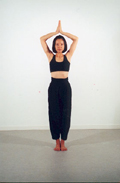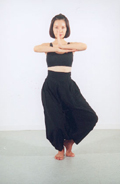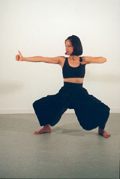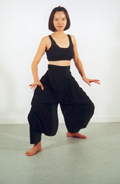TEN MOVEMENTS THAT STRENGTHEN THE ESSENTIAL ENERGY IN THE CORE (ELEMENTAL MASTER SERIES) *DASHA SHAKTI-VIKASHAKA VYANGA TAN-STHANAM ABHYASA-KRAMA*
1º. Vyanga: The Inverted Mountain
This Vyanga is one of the most important, and can be considered the king of all vyangas. The benefits of each Vyanga are multiple, but this one has its main benefits in the shoulders, elbows and hands, giving them strength, unblocking tension and releasing inert energy in these areas.
It strengthens and liberates the shoulders and is revitalizing and balancing physically, energetically and mentally. For this reason, this posture not only affects the body but also the mind giving it strength, harmony and balance. It tones the central nervous system, drains the lungs, expands the thorax cavity, strengthens the pleura, increases breathing capacity, protects the heart and renews the bloodstream and lymphatic flow. It increases the volume of the thorax, the body expands and the muscles are strengthened. This Vyayam figure is equivalent to the headstand position (Shirsasana) in Yoga. It works on the Vital Energy points and the cordial axis (Manipura and Anahatha Chakras).
2º. Vyanga: Building and raising the dome of the Temple
This is a figure that prepares warriors on an energetic level. By raising our hands we visualize that we are raising the dome of a temple. It strengthens and releases tension in the shoulders, arms, wrists and neck and also releases muscular tension in the chest by opening the thymus gland and freeing emotional tension.
It drains the kidneys and the lungs and helps to correct back problems by spreading prana, vital energy, along the spinal column. By separating each vertebra from its cradle, it liberates the nerve impulses of the main nodules that tone the vital organs of the body. It works on the cordial axis core, on the vital force base and the three great vital rivers, Anahata chakra, Nabhi Aditala, and the nadis Brahma, Ida and Pingala.
3º. Vyanga: Lighting the lamp that illuminates the heart
Symbolically this is the representation of the Knowledge of the Heart, Essential Wisdom. It awakens feelings such as love and compassion and in ancient India when the masters were ready to teach they established themselves in the mudra that this figure portrays.
This figure provides us with physical and emotional balance, nourishing us with upright and balanced thoughts that open the energy centre of the heart bringing us mental serenity. It purifies the centre of external attention and works the cordial centre and the projection of external awareness. (Anahatha and Nasagra AdiTala).
4º. Vyanga: The Archer that shoots the big Bow
This posture is performed by holding the bow with the hands, focusing the mind on a fixed point and shooting the arrow towards the target. It is a warrior position and symbolizes the process of Yoga: the bow is the body, the arrow the mind, the target is the object of concentration and the bowstring, the discipline of the method. “He who concentrates flows with the object of his attention”.
It expands the chest, strengthens the arms and torso giving us a healthy appearance, strength and security. It regulates accumulated energies, balances the thymus gland and reinstalls self-confidence. It works the nucleus of the breath and the projection of inner attention. (Vishuddha Chakra and Brumadhya Aditala).
5º. Vyanga: The step of the Mighty lion or Tantric dragon
These are the steps applied in martial arts, fighting steps which give the warrior great confidence. It gives immense strength to the thighs and legs and stimulates and regulates the heartbeat. It is a great physical exercise and its regular practice is the equivalent to jogging. It increases the respiratory capacity and actively works the kidneys and the regulation of the temperature of the body and metabolism.
It helps the peristaltic movement alleviating inflammation of the intestines and activates sexual performance by stimulating adrenaline. It works the heart axis, the centre of strength in the body, the dwelling of creative sexual energy and the three great vital rivers (Anahata Chakra, Manipura Chakra, Svadhisthana Chakra, Nabhi AdiTala and the nadis Brahma, Ida and Pingala).
Go up




